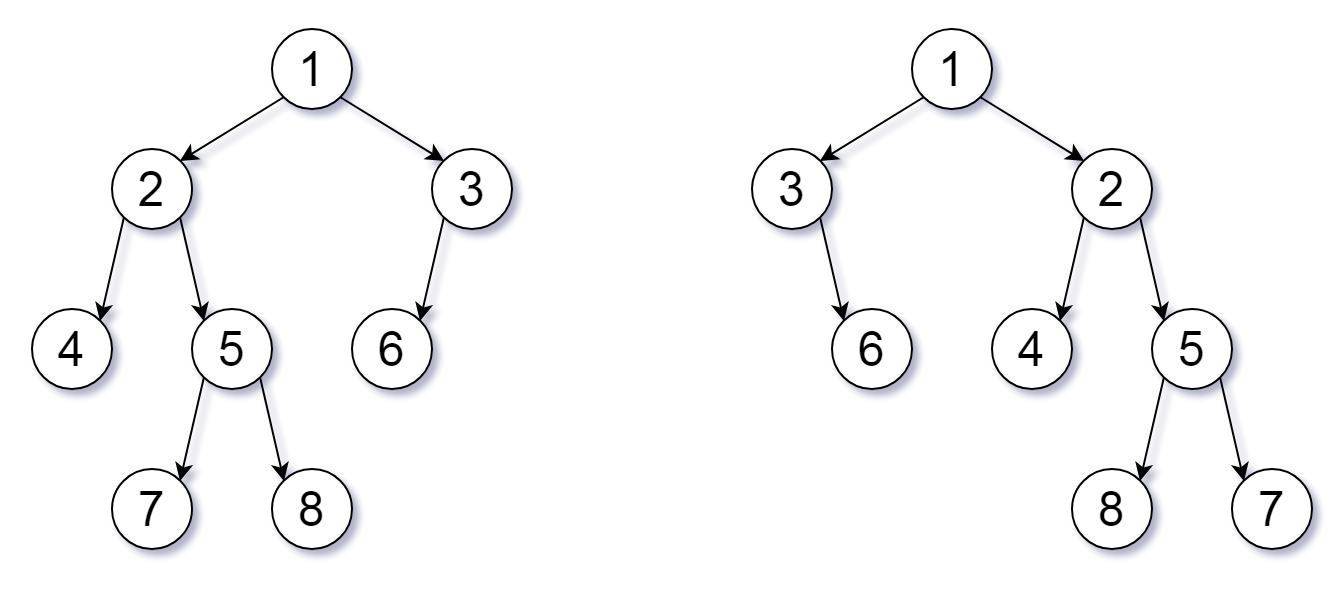951. Flip Equivalent Binary Trees
For a binary tree T, we can define a flip operation as follows: choose any node, and swap the left and right child subtrees.
A binary tree X is flip equivalent to a binary tree Y if and only if we can make X equal to Y after some number of flip operations.
Given the roots of two binary trees root1 and root2, return true if the two trees are flip equivalent or false otherwise.
Example 1:

Input: root1 = [1,2,3,4,5,6,null,null,null,7,8], root2 = [1,3,2,null,6,4,5,null,null,null,null,8,7] Output: true Explanation: We flipped at nodes with values 1, 3, and 5.
Example 2:
Input: root1 = [], root2 = [] Output: true
Example 3:
Input: root1 = [], root2 = [1] Output: false
Constraints:
- The number of nodes in each tree is in the range
[0, 100]. - Each tree will have unique node values in the range
[0, 99].
class Solution {
public:
bool flipEquiv(TreeNode* root1, TreeNode* root2) {
return dfs(root1, root2);
}
bool dfs(TreeNode* root1, TreeNode* root2) {
if (root1 == root2 || (!root1 && !root2)) return true;
if (!root1 || !root2 || root1->val != root2->val) return false;
return (dfs(root1->left, root2->left) && dfs(root1->right, root2->right)) || (dfs(root1->left, root2->right) && dfs(root1->right, root2->left));
}
};JAVA
/** * Definition for a binary tree node. * public class TreeNode { * int val; * TreeNode left; * TreeNode right; * TreeNode() {} * TreeNode(int val) { this.val = val; } * TreeNode(int val, TreeNode left, TreeNode right) { * this.val = val; * this.left = left; * this.right = right; * } * } */ class Solution { public boolean flipEquiv(TreeNode root1, TreeNode root2) { return dfs(root1, root2); } private boolean dfs(TreeNode root1, TreeNode root2) { if (root1 == root2 || (root1 == null && root2 == null)) { return true; } if (root1 == null || root2 == null || root1.val != root2.val) { return false; } return (dfs(root1.left, root2.left) && dfs(root1.right, root2.right)) || (dfs(root1.left, root2.right) && dfs(root1.right, root2.left)); } }
PYTHON
class Solution:
def flipEquiv(self, root1, root2):
return self.dfs(root1, root2)
def dfs(self, root1, root2):
if root1 == root2 or (not root1 and not root2):
return True
if not root1 or not root2 or root1.val != root2.val:
return False
return (self.dfs(root1.left, root2.left) and self.dfs(root1.right, root2.right)) or \
(self.dfs(root1.left, root2.right) and self.dfs(root1.right, root2.left))
Comments
Post a Comment